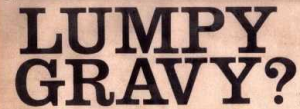So why did I call this blog post “client engagement- full of whipped cream and lumpy gravy?” Often both are ‘heaped’ onto the poor (final) solution found underneath the client- consulting engagement process. Both are layered on to mask the truth that the ones responsible don’t really understand how to make this process really work.
Managing innovation suffers from this an awful lot. We do need to understand all the ingredients that make up innovation, often we just try to’ top’ them off, failing to understand everything that needs to become part of the final solution.
I’m sure many of you have witnessed or been involved in poor client- consulting engagements. Often the root cause of poor end results within this process stems from a poorly structured engagement briefing process – my lumpy gravy.
This creates the effect of creating many problems in delivering back not the best advice or solution to the real problem, offering up the lashings of whipped cream to cover up the bland solution dish underneath.
The engagement process does still rankle for me as it causes many of the difficulties and tensions within the emotions that many projects seem to swing through – trusted and distrusted — loved and despised — all in equal measure where many variations could be reduced with a little thinking and challenging.
Avoiding some of the pitfalls
So I thought I’d take a look at some of the problems within the client – consulting engagement process that can mask what is really lying underneath.
 Firstly we more than often than not, get the lumpy gravy served up from the client’s side. The client serves up the lumpy gravy as they want to cover up the problems and challenges they really have or they even can’t describe it as they are not sure of the outcome they are looking for.
Firstly we more than often than not, get the lumpy gravy served up from the client’s side. The client serves up the lumpy gravy as they want to cover up the problems and challenges they really have or they even can’t describe it as they are not sure of the outcome they are looking for.
All they want to do, is to call in the consultant to get them to try and chew their way through the existing meal, hoping they can eventually sort out the issues, make it more palatable. They react and call for immediate help, rather than go back to the basics and think through the ‘connected’ issues. Let others sort that out and leave the consulting brief very open, cover it up with this lumpy gravy.
 On the other hand, the consultant layers it on with their whipped cream. Those that are delivering plenty of whipped cream to make for a finished presentation that often has little substance but lots of sugar.
On the other hand, the consultant layers it on with their whipped cream. Those that are delivering plenty of whipped cream to make for a finished presentation that often has little substance but lots of sugar.
Hopefully also a little addictive and fattening so that the clients is always appreciating the finished effect, delivered in that final flourish, yet not really understanding what makes up the dish and asking simply for more.
So why do we have an engagement process?
Actually it is to stop the covering up of poorly conceived and hastily developed and deficient executed solutions without clearly thinking these through.
Often good innovation is never delivered on the plate easily, it is hard work. Often good engagement results are lacking, as the depth of understanding of the complexities are often ignored.
Often the trap is failing to have the right understanding, skills and application to be applied, leaving for just adequate end solutions offering mediocre and further erratic results. Sorry but that is it!
I believe through decent in-depth discussions pre-engagement we can achieve better results
Surprising this ‘decent’ pre-engagement often does not happen, and you can spend a fair amount of your time revising your proposal after certain discoveries.
The problem today is that caused by the pressure of time, as most the issues always seem to have a certain ‘burning platform behind them. The pressure is to quickly find solutions that fix immediate problems without the necessary depth of discovery to resolve the underlying cause.
I would strongly argue clients should invest in a discovery phase before everyone gets deeply involved in project structures, costs or possible solutions. Sadly the majority of clients are not prepared to pay for this, often believing their rambling brief, many times just verbal and often in snatched, scrabbled conversations is good enough. To be totally honest they are not.
On the consulting side, if you probe too much, early on, it makes the client uncomfortable when that should actually be the effect, as it brings out and confirms the real issues in potentially a better proposal. At least it can get you closer to the real issues underneath.
Sometimes the client suddenly is unavailable, they do not return the calls but by then you have either lost out because you were not the mind reading expert they expected as they are too busy fire-fighting and little time for putting quality time into their thinking.
So let me offer some of my favourites where clients serve up ‘lumpy gravy’.
- Briefs that are so limited that you have to spend inordinate amounts of time painfully extracting the real underlying challenge or issues. Often you lose out because you were not the mind reading expert, as they were really waiting to read the different submissions to decide on what they needed to do as they did not have a clue and were on a ‘fishing’ expedition.
- Another one is clients hand over such a short brief, pushed through to the procurement department and just let them go through the discussions and evaluations. The consultant can’t even talk to the eventual client.
- Then you have procurement who does their job of looking for the most economical proposal, leaving the eventual client often forced to work with that provider of services irrespective, eventually complaining of “that consultant was no good”- surprise!
- One other favourite is a reworked and passed around document, one that has been revised countless times by all internal stakeholders to make the end briefing result as exciting as flat warm beer – still just about enough strength but no character or uniqueness but it “wets the whistle” as we say.
- Often you experience the one where the brief arrives months after it should have, due to this internal dialogue process being interminable. The client has that sudden fear someone above them is beginning to ask questions about this. Equally the year-end is coming up and the client races to turn the investment commitment into actual and push the consultant to reply within forty-eight hours or something as ridiculous.
- One more, is to take out the real issues; I mean who honestly wants to admit they have real issues? Heaven forbid, that might be carer limiting if it gets out. Just offer a hint of excitement and flavour to the consultant and once they are ‘on the inside’ the client opens up, Caught often by surprise, the consultants scrabble to draw in additional resources, rapidly try to revise their solutions and get into renegotiation mode creating tensions and questioning for the broader stakeholders, making all go on the defensive. Not a good place to start any engagement process.
I can recall where one potential client deliberately ‘released’ a tender over a holiday weekend, opening the tender offer on Friday, late afternoon, with a cut off on the Monday – the holiday day. That way the number of submissions were significantly limited and his favoured one ready to be submitted, could be chosen by the committee, set up to review all tenders. That perhaps is a ‘lumpy gravy’ of another kind.
All these ‘lumpy gravy’ moments have real tension within them, due to the lack of a well thought through brief. Often so many with ‘vested’ interests enter the discussions all getting ‘stuck in’ to fix the lumpy gravy of a poorly conceived proposal.
As they say “too many cooks spoil the broth” and the end result ends up with blander, watered down proposals. Conflicts and issues are put off until later.
Examples of adding more whipped innovation cream back to the client.
- If you want to make everyone purr with contentment just keep throwing in “best practices” and “benchmarking competitors” or “evaluating market leaders” as one part of the topping off
- The other is laying out the ingredients of the innovation solution dish to make sure there is sufficient taste appeal such as “we provide a diagnostic” or “we believe in conducting in-depth interviews” usually triggers and ticks some of the taste boxes.
- When consultants receive a short briefing call, asking for help, the consultant ‘grabs’ all his pre-cooked solutions off the shelf or from the deep freezer and turns these into instant solutions and uses these to offer up quick answers.
- Then you get a number of consultants who have formulated their solutions before they even arrive at the clients for the kick off meeting and irrespective ‘drive’ solutions towards this but work very diligently to squeezing them into the solution box.
- Or, after a brief period at the clients busily gathering data, conclusions are made and with the on-site consulting team locking themselves away for a few days producing their ‘all singing and all dancing’ Power Point deck of 200 slides, full of the ‘mind numbing’ structure and process descriptors, leading to their conclusions with those all listening simply ‘blanking out’.
- How often does that growing sense of the consulting company, that was brought in, actually seems like they have gone beyond their own competence level and begin to ‘gain experience’ at the clients cost and famously ‘tap dance’. Whipped cream can cover much!
- The last one here, is the client only real reason in calling in another consultant was to clear up another consultants mess. That puts a really different spin on things and suddenly reputations are far more at stake. The new whipped cream might briefly foam up and then go flat as the situation was simply not really a recoverable one.
So the consultant has to often be ready with lashings of whipped cream to mask the content underneath. Sometimes a little honestly, which often is in sparing doses, might be a better solution. I’d rather lose an engagement than work in highly constrained situations where no one is eventually happy.
Clients, I believe value candour, some humility from consultants and a high level of transparency than often consultants like to project: fully confident, the authority and masking the solutions with the pretence of perfection. Whipped cream can only go so far.
Avoiding whipped cream and lumpy gravy.
It is a pity, especially where we are dealing with innovation as it is often a messy process and this should be a clear recognized on all sides. Solutions need to be unique as no two situations are the same. Solutions often ’emerge’ through an open, sometimes highly experimental process that requires this collaborative approach, where client and consultant truly do work alongside each other, complimenting and contributing together. Here is where by really combining they can offer different insights for ‘emerging’ solutions that tackle unique distinctive challenge and learn from each other.
I like working through four principal steps in any engagement process. They all need working through really well – discovery, generation, conversion and finally, diffusion and acceptance. I adopted my approach from learning from others and provided a visual of this can be seen in a previous post.
Try to avoid the whipped cream and lumpy gravy within the client- consulting engagement process, it masks some fairly unhealthy outcomes if this is not managed well.


One thought on “Client Engagements – Full of Whipped Cream and Lumpy Gravy”
Comments are closed.